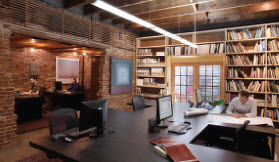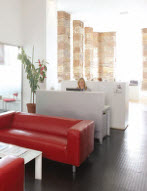Corporate Convertibles
Radical transformations of existing buildings can provide chic and functional offices, Deborah Erwin discovers.
While it might seem more humane to pull the plug on some sad and dilapidated buildings, many yearn to be awoken from their comas and given a second chance at life. With congested urban centres and skinnier construction budgets in light of the economy, many forward thinking companies are considering refurbishment and retrofitting as a viable alternative to a new-build project. After all, what better way to attract positive publicity than aligning oneself and one’s business with a chic retrofit operation? Most people are beguiled by stories of the ugly or old made beautiful and fresh. The same applies for buildings. Upon viewing the new fit-out people will gush and praise the transformation, because it’s a visionary reuse of space.
|
|
The project executors will not only have beautified an otherwise obsolete and unattractive building, they will also have extended its lifespan, retained its good attributes, given it a modern purpose and often improved its environmental impact. Apart from these reasons, there are practical motivations to retrofit such as updating a premises’ safety standards, improving accessibility and circulation and modernising layouts for contemporary use. Designers tasked with these projects also disclose (sometimes through gritted teeth) that such work requires a different creative process than new builds which often afford carte blanche. You need to ‘think inside the box’, rather than outside of it. Here are some exemplars from around the world which convert a furniture emporium, clothing manufacturing factory, school building and street-level shop into offices.
John’s Decor Building (Adelaide)
|
|
John’s Decor Building, a state-heritage structure in Adelaide (South Australia) has recently been transformed into an office block. During the 1920s, the three-storey building was frequented by homeowners who sought furnishings at Hooper’s Furniture Emporium. Today the neighbourhood has been refashioned into a creative enclave for artists. The building itself now accommodates Sarah’s Cafe and offices for Clemenger BBDO, MNet, Priceline. As part of the refurbishment process, recently acquired Woodhead Architects endowed the entry foyer with a full height void encased in windows, thus linking each floor and allowing for light transfer from the outside. Retained features include the original timber staircase and lift, wood skirtings, plaster cornices and Jarrah Wood floors. Apart from these retained materials, energy efficient lighting and modular dividers are adopted throughout. Interiors flaunt open and airy layouts with ‘fish bowl’ meeting rooms for optimal transparency. Its outfit for Clemenger BBDO, an edgy advertising agency, involved inserting mobile workstation set ups and a variety of environments ranging from highly-interactive spaces to isolated pods throughout its 900 sqm. This design approach allows for informal staff gatherings and client meetings, and is revealed beyond the reception area. Guests are greeted at a counter faced with backlit honeycomb sheeting, producing a similar allure to a smouldering fireplace. This transitions into a breakout space with a bar top and stools. Given the nature of the business, the design needed to facilitate the stimulation and free exchange of creative ideas. Thus a four-metre workbench covered with a roll of paper enables people to jot down images and thoughts then pin them on the walls. Clipboards suspended on high tensile cables also permit in-house dialogue in a light-hearted manner.
AxD (Philadelphia)
|
|
With only two years under its belt, architectural firm AxD or Always by Design, took over a 19th century row house in Philadelphia, a semi-detached unit surrounded by other similar three-to-four storey brick buildings. Situated on a zig-zag parcel, the building was formerly used as a warehouse and service alley yard. Totalling 1,840 sqf, the site was sensitively renovated with out-of-pocket expenses of US$82,000 (under $45/sqf). Its revived programme includes a gallery, reception area and studio. The storefront’s nondescript concrete frame and single-paned windows were replaced with a butt-glazed glass corner and Douglas Fir panelling to articulate a clean and modern doorway. Douglas Fir also clads the gallery’s walls, and by applying a striping effect kept material wastage to a mere two percent.
Visitors enter through this open, sparse and undefined corridor running the length of the site for use as a foyer, exhibition area, lecture room and social venue. To artfully connect the gallery, reception area and architectural studio, the designers punched through a brick wall and left its jagged edges for effect. The reception alcove houses administrative desks, storage and a pantry while the studio is given a cottage-like atmosphere with rugs, wall-to-wall wood shelving, exposed brick walls and ceiling beams. Original masonry, concrete and wood moulding are preserved. After removing five layers of floor treatments and carpeting, original red pine boards were patched with reclaimed lumber and treated to an ebony finish. Ceilings vary throughout the project. Clean and flush white surfaces are opted in the gallery while the reception space flaunts warm wood panels and the studio maximises its room height by exposing original beams. The unfinished basement was transformed into a prototyping and model-making workshop and records archive. The lot’s backyard is furnished with patio furniture providing the office with a relaxed spot for meetings and coffee breaks.
Saucier + Perrotte Architectes office (Montreal)
Saucier + Perrotte Architectes adopted a 60-year old clothing manufacturing building in Montreal’s Little Italy district for its office. The three-storey brick structure is adjacent to other low-rise industrial blocks which have been refurbished into residential complexes.
From the street level entrance, one descends a few steps to a sub-level where the firm’s reception area, conference room, administration department, workshop and gallery are housed. Long workbenches and mid-height shelving units delineate work areas, each with a slate frontage which anchors them to an industrial motif. And since this company also encourages original thought, blackboards are employed for walls as well. The upper floor provides for the main studio space and partners’ offices while the top floor is used as residential units. For ease of communication between the two office floors, a 20 sqm void was cut into the shared concrete slab. Here a shaft of stairs with an industrial aesthetic links the two. During renovations the exterior walls, structural beams, hardwood maple floors and steel radiators were preserved. To keep interiors bright and to maximise the space, open ceilings are coated in white and uplit, windows span the entire width of exterior walls and translucent dividers allow for diffused light penetration.
Victorian school building (Glasgow)
Developer LoftOffice and architectural practice CRGP Limited worked together to restore and rework this Victorian red sandstone school building into an office complex. Located on the corner of Stanley Street and Portman Street in Glasgow, the imposing block is now home to Glasgow City Council, occupying the first three floors, CRGP Limited’s office on the fourth floor and LoftOffice, TPT (an architectural firm) and the Scottish Middle Eastern Council on the fifth storey. CRGP served as project manager, architect, quantity surveyor and construction (design and management) co-ordinator for the project. The overall conversion cost GBP 2 mil while CRGP’s office fitout amounted to GBP 300,000. Its own office took 12 weeks to complete which involved the installation of IT infrastructure. Since the original classrooms were large open rooms, these were easily transformed into bright and airy offices. Interiors reveal exposed stone walls and folding classroom partitions for use as temporary dividers. The school’s rooftop playground now serves as a terrace for the tenants.


